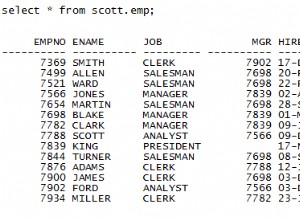Jeśli chcesz policzyć duplikaty w wielu kolumnach, użyj group by :
select ColumnA, ColumnB, ColumnC, count(*) as NumDuplicates
from table
group by ColumnA, ColumnB, ColumnC
Jeśli chcesz tylko wartości, które są zduplikowane, liczba jest większa niż 1. Otrzymasz to za pomocą having klauzula:
select ColumnA, ColumnB, ColumnC, count(*) as NumDuplicates
from table
group by ColumnA, ColumnB, ColumnC
having NumDuplicates > 1
Jeśli rzeczywiście chcesz, aby wszystkie zduplikowane wiersze zostały zwrócone, połącz ostatnie zapytanie z powrotem do oryginalnych danych:
select t.*
from table t join
(select ColumnA, ColumnB, ColumnC, count(*) as NumDuplicates
from table
group by ColumnA, ColumnB, ColumnC
having NumDuplicates > 1
) tsum
on t.ColumnA = tsum.ColumnA and t.ColumnB = tsum.ColumnB and t.ColumnC = tsum.ColumnC
To zadziała, zakładając, że żadna z wartości kolumny nie jest NULL. Jeśli tak, spróbuj:
on (t.ColumnA = tsum.ColumnA or t.ColumnA is null and tsum.ColumnA is null) and
(t.ColumnB = tsum.ColumnB or t.ColumnB is null and tsum.ColumnB is null) and
(t.ColumnC = tsum.ColumnC or t.ColumnC is null and tsum.ColumnC is null)
EDYCJA:
Jeśli masz NULL wartości, możesz również użyć NULL -bezpieczny operator:
on t.ColumnA <=> tsum.ColumnA and
t.ColumnB <=> tsum.ColumnB and
t.ColumnC <=> tsum.ColumnC




